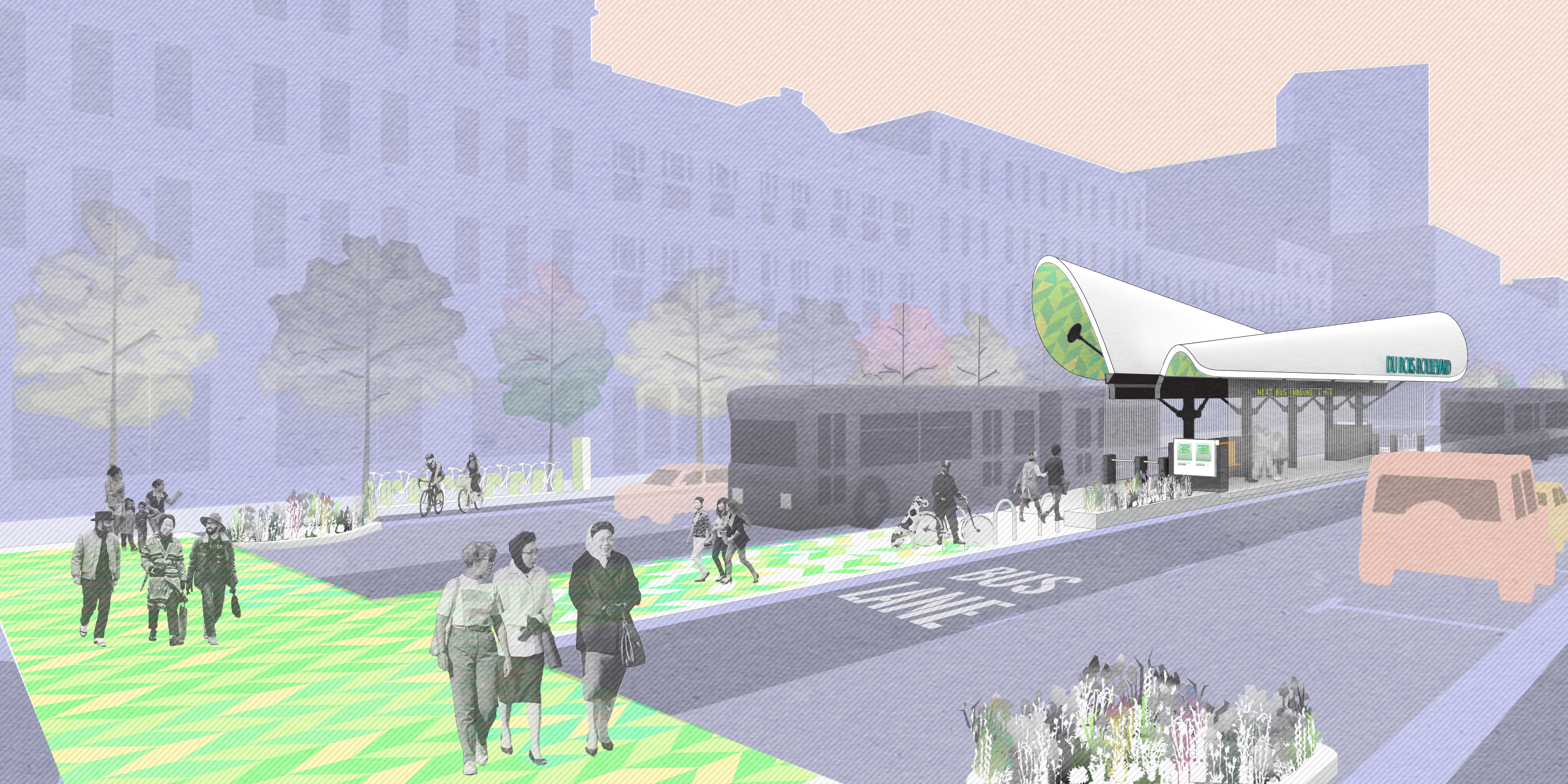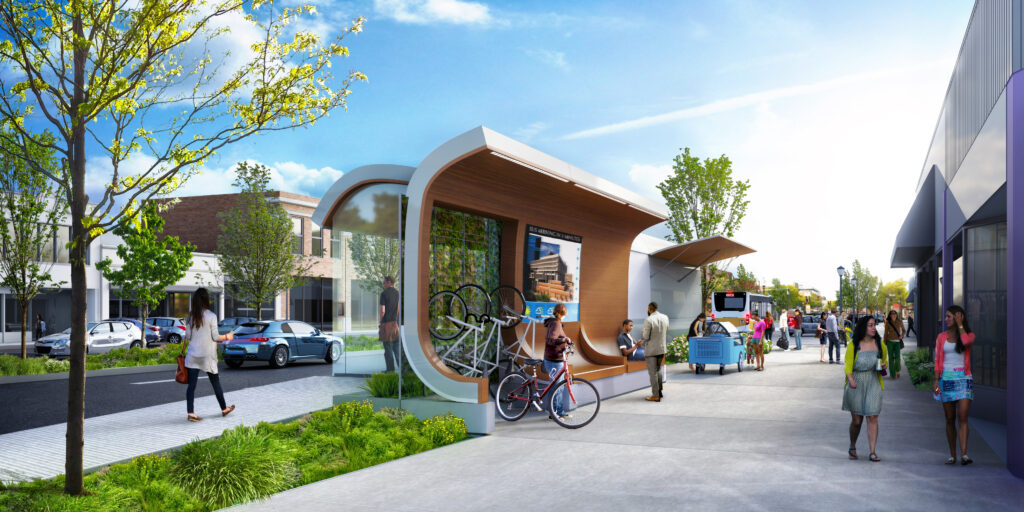The BostonBRT Station Design Competition is an ideas competition for Bus Rapid Transit (BRT) stations in Boston. The competition created an opportunity for designers to showcase creative, innovative and inspiring modern design for a critical part of the BRT System: The Station.
BostonBRT challenged the design community to think beyond the traditional bus stop and bring to life exciting new ideas for BRT stations in Boston. Better bus stops, combined with other elements of “Gold Standard” BRT can help transform the transit experience for Boston commuters. The three winners were selected on the following criteria:
- Reflect the character of Greater Boston and its neighborhoods
- Create a sense of comfort and elegance
- Meet the requirements of the BRT Standard and maximizes benefits to future BRT riders
- Allow for integration with other modes including walking and biking
- Demonstrate an effective and reliable rapid transit system.
Covered stations are a core feature of the BRT experience. While traditional buses have “stops” marked only by a sign and sometimes a bench, BRT vehicles come and go from stations that are sheltered, weatherproof, brightly lit, and architecturally exquisite.
What is BRT?
BRT, which doesn’t yet exist in Massachusetts, is a transformational bus system being adopted by cities around the world to carry millions of people comfortably and reliably each day. Because BRT contains features similar to a light rail or metro system, it is much more reliable, convenient and faster than regular bus services. With the right features, BRT is able to avoid the causes of delay that typically slow regular bus services, like being stuck in traffic and queuing to pay on board.
BRT improves upon the standard bus in several key ways, including:
- A dedicated right-of-way: Bus-only lanes make for faster travel and ensure that buses are never delayed due to mixed traffic congestion
- Busway Alignment: Center of roadway or bus-only corridor keeps buses away from the busy curbside where cars are parking, standing, and turning
- Off-board Fare Collection: Fare payment at the station, instead of on the bus, eliminates the delay caused by passengers waiting to pay on board
- Intersection Treatments: Prohibiting turns for traffic across the bus lane reduces delays caused to buses by turning traffic. Prohibiting such turns is the most important measure for moving buses through intersections – more important even than signal priority.
- Platform-level Boarding: The station should be at level with the bus for quick and easy boarding. This also makes it fully accessible for wheelchairs, disabled passengers, strollers and carts with minimal delays.
The Winners
First Place Winner
The Billow
The Billow station’s iconic design provides a distinctive brand for Boston’s BRT network and an elevated experience for transit riders. The unique diagonal column alignment allows for generous platform space toward the front of the bus and the double canopies, facing opposite directions, result in a dynamic overall form.
For curb-aligned stations, the diagonal structure creates space for a kiosk in high-traffic locations. By co-locating a coffee shop or fruit stand with a BRT station, a prosaic bus stop is transformed into a lively public space. Moveable café chairs can serve double-duty as a pleasant place to wait for the bus.
The Billow station is at once sculptural and weightless. While the roof is the natural grey of composite concrete, the underside is adorned with brightly colored decorative patterns or murals customized for each neighborhood. These richly ornamented ceilings are recessive during the day, when the hustle and bustle of the city dominates. At night, up-lighting will convert the stations into welcoming beacons.
The crosswalks leading to the stations are extensions of the art featured on the underside of the canopy. Their design will serve as invitations to the stations and help make transit an organic part of the neighborhood.
Second Place Winner
RootBRT
RootBRT is a station experience designed to adapt to a neighborhood community’s desires while ensuring efficient transportation links between under-connected neighborhoods and regional job hubs. A modular construction method reduces costs and guarantees flexibility, with three foundational components (Comfort, Anticipation, and Transition) that can be configured in countless ways to usher users from existing urban fabric into exciting spaces providing interaction, service, and transport.
The integration of information delivery via interactive display (BusRapidBoards, or “BRBs”); pedestrian amenities such as seating, shade, and locally-owned micro-retail; and gold standard fare collection and buses provides each station location and its users with a range of resources to improve physical and social connectivity. With a constant consideration for sustainability and resiliency, the standardized modular structures kept most construction activity off-site, minimizing disruption to the neighborhood while channeling cost savings into higher quality amenities and resiliency features such as stormwater collection, solar PV collection, and reclaimed local materials.
The end result is a station that local residents and business owners are proud to call their own, one that creates stronger connections between neighbors and neighborhoods.
Third Place Winner
Urban Arbor
The Urban Arbor proposes a new mobility aesthetic, unique for the City of Boston. Visually rooted in the palette, scale, and texture of the Boston context, the Urban Arbor is not just an infrastructural component, it is a social, ecological, and memorable icon for the future Boston BRT and the city as a whole.
Urban Arbor capitalizes on both the characteristics of mobility and of Boston. Mobility often has associations with high-tech, futuristic, structural expression, sleek-ness. Whereas, Boston is associated with the historic, detail, and warmth. The project attempts to negotiate and challenge these two sets of characteristics; being sympathetic to the historic nature of the Boston neighborhoods, while also representing the technological advancements of the BRT infrastructure.
Urban Arbor is characterized by the integration of deep planter gardens, which serve visual, social and ecological purposes for the station. Visually, the planters soften the edges of the station and provide a barrier between the waiting areas and adjacent traffic flows. Socially, the community can help to determine which plants are used and, through a volunteer program, aid in the maintenance of the garden. Ecologically, the roof of the station acts as a rainwater recovery system, allowing stormwater to drain directly into the planter gardens. Integrated solar panels on the roof allow the LED lighting and wayfinding systems to be fully off the grid.
For more information about the station design competition and to see all the entries, check out bostonbrt.org.




